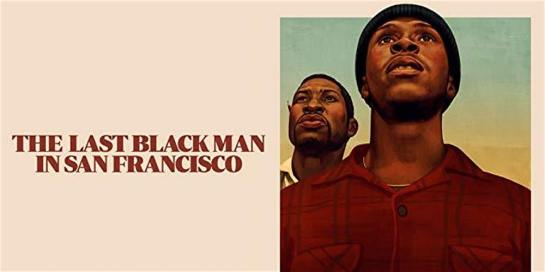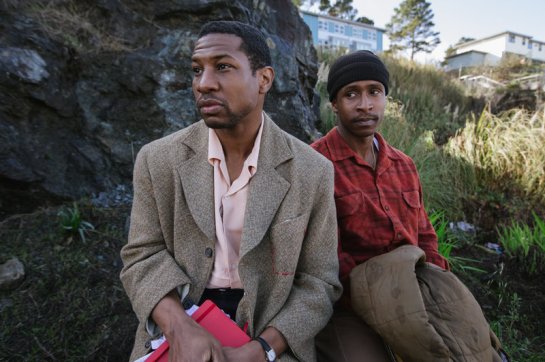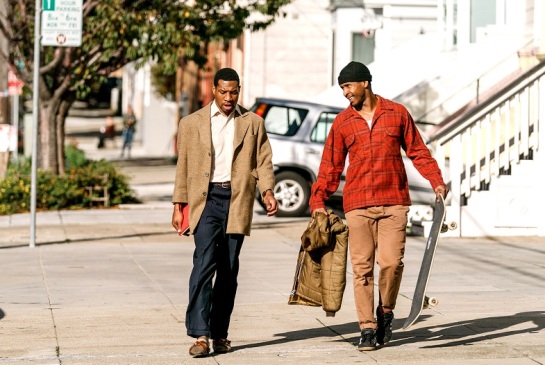
The opening scene of “The Last Black Man in San Francisco” is a stunning slice of filmmaking. It’s beautiful, elegant, and provocative. It highlights a budding filmmaker already showing off terrific instincts when it comes to harmonizing music with cinema’s visual language. And it sets the table for this clear-eyed love letter to a city and thoughtful meditation on the meaning of ‘home’.
“Last Black Man” is the inspired feature film debut of director Joe Talbot. He conceived the story alongside his long-time friend and the film’s star Jimmy Fails with Rob Richert co-writing the screenplay. The story sees Fails playing a version of himself while telling a version of his actual life growing up in the ever-changing city of San Francisco.

Photo: A24
The aforementioned opening begins with a young girl looking up with childlike curiosity. We then see the object of her gaze – a man in a hazmat suit picking up trash. She begins skipping and a tracking shot follows, eventually settling on a street preacher and his audience of two. The two men, Jimmie (played by Fails) and his best friend Montgomery (Jonathan Majors), are there to catch a bus but decide they have waited long enough. The scene then transitions to the friends scooting across San Francisco neighborhoods on Jimmie’s skateboard, their destination still undefined. The use of slow-motion and the way the camera draws in on faces are just parts of the effective technique.
The two friends arrive in the Fillmore District, stopping at a particular Victorian home. This is our introduction to what could be considered the movie’s central relationship between Jimmie and this house. We learn it was Jimmie’s childhood home and his grandfather built it in 1946. Exploring the idea of gentrification, the house is now occupied by an older middle-class couple and the neighborhood has a much different look than when Jimmie was a kid.
Jimmie and Montgomery live in a cramped house with Mont’s grandfather (Danny Glover) in the poorer Bayview-Hunter’s Point. But Jimmie dreams of owning the house of his youth and sneaks in to work on the old Victorian whenever the older couple are away (They would rather he not). It’s an impulse driven by powerful memories but also a deep personal yearning for a dream that may already be out of reach. That taps into one of many thematic threads that run through the sometimes meandering but always honest story.
From its earliest moments to its crushing final shots, Talbot makes San Francisco itself a fundamental part of every scene, either visually or through the characters who always convey some element of the city’s effects. The rich cinematography from Adam Newport-Berra give sight to the tangible, organic love Talbot and Fails share for the Bay Area. And the harmony of Emile Mosseri’s operatic score along with a couple of beautifully employed cover songs add to the film’s ever-present sense of love and longing.

Photo: A24
“You’re not allowed to hate it unless you also love it.” By the time Jimmie utters these words we have already watched him endure hardship and disappointment. Yet he defends his city even as his city ignores him. Fails speaks from his heart and rarely does his screenwork come across as a performance. It is soulful, funny, and full of feeling. And I can’t say enough about Jonathan Majors and the life he brings to Mont whose story is in itself both tender and heart-rending.
“The Last Black Man in San Francisco” has a lot to say about a lot of things. But it never loses sight of its most important element – humanity. The movie is a window into the human experience from some truly enlightening perspectives. And even during some of its slower moments it never loses that effect. It makes the film’s final shots more tragic and the sting of it will stick with you for days.
VERDICT- 4 STARS


I’m so glad you enjoyed this! It was one of my favorites of this past year. Just a beautiful film.
It really is. That final shot absolutely crushed me. I’ve been meaning to write about this film for a while. I really don’t think I did it justice.
This looks good, Keith. Sounds like the ending grabs and shakes you. Thanks for bringing it to my attention.
That ending…whew. It left a lump in my throat for sure.
I kind of wanted to see this as I read it, but then “crushing final shots” and “final shots more tragic” makes me think I’ll be having a weepfest, which I dislike doing almost as much as horror movies!
It’s not that kind of ‘tragic’ or ‘crushing’. It does have an emotional punch, but it’s much more…sadly contemplative (if that makes any sense whatsoever.
OK I’ll risk it when I catch sight of it!
I had this film in my watchlist but it never came to my local multiplex. I heard really good things about this.
It’s worth checking out. I missed it in the theater too. It’s a pretty terrific debut.
Great review. From what I’ve read, the film looks brilliantly written. I love evocative stories that have something meaningful to say, and am looking forward to seeing this!
This movie certainly fits your description. It is evocative and it does have meaningful things on its mind. Hope you can see it soon.
Sounds interesting.
It really is. It packs a pretty good punch.
Pingback: REVIEW: “The Last Black Man in San Francisco” — Keith & the Movies | Los Angeles feedback film festival